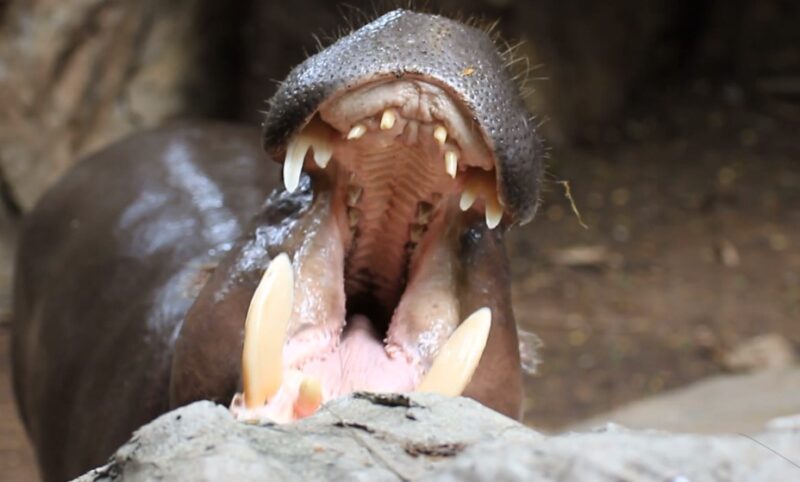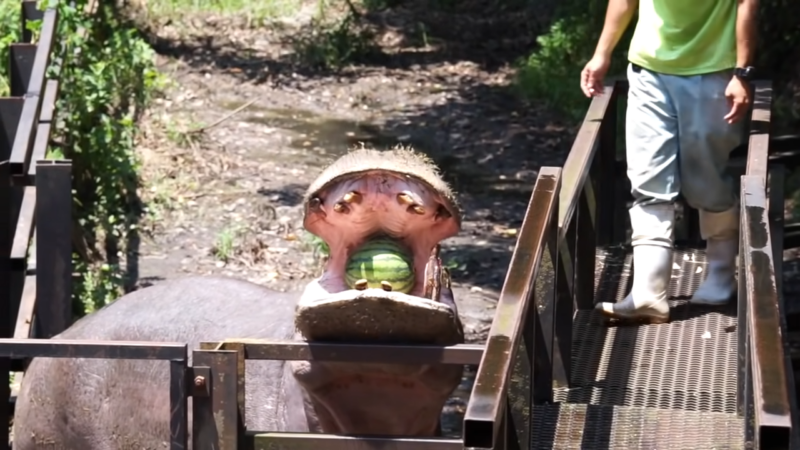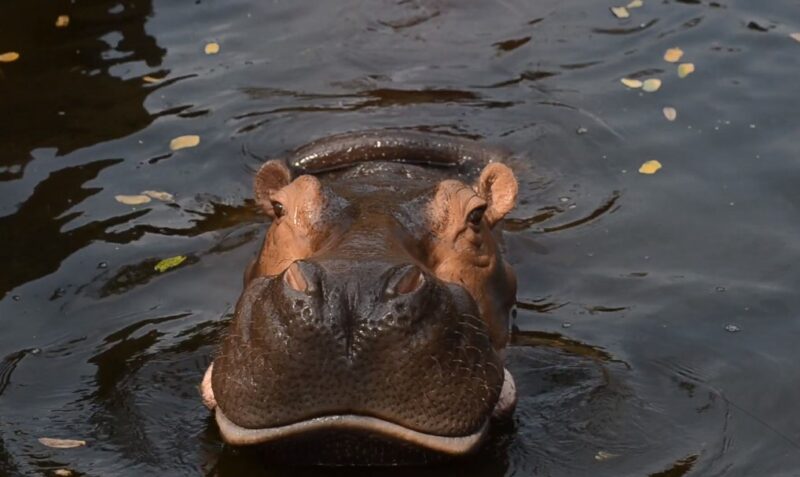As a devoted zoologist who regularly tends to the well-being of hippos, I find these magnificent creatures to be truly captivating. Hippos (Hippopotamus amphibius) are awe-inspiring semi-aquatic mammals and an essential part of their ecosystems.
Researching their dietary habits is of utmost importance for their conservation, both in captivity and in the wild. In this comprehensive article, we will delve into the fascinating world of a hippopotamus’s diet, explore their primarily herbivorous eating habits, and examine the recommended portions for a healthy and contented hippo.
Nature

Hippos are considered obligate herbivores, meaning their diet consists entirely of plant-based materials. Their powerful jaws and impressive teeth are specifically designed for grinding and chewing plant matter. This herbivorous nature differentiates them from carnivorous or omnivorous animals and influences their feeding behaviors significantly.
Obligate Herbivores
Hippos proudly wear the badge of obligate herbivores, signifying their complete reliance on plant-based materials for sustenance. Unlike some of their predatory counterparts or adaptable omnivores, hippos have evolved to rely solely on a herbivorous diet. This adaptation is crucial in shaping their physical anatomy and digestive systems to extract maximum nourishment from plants.
The Incredible Jaw Power
A hippo’s jaw is a true marvel of natural engineering. With muscles that can generate extraordinary force, their jaws are built for grinding and crushing tough plant matter. These powerful jaws allow hippos to masticate even the hardiest of plants, breaking down fibrous cellulose and extracting nutrients effectively.
In fact, a hippo’s bite force can reach jaw-dropping levels, averaging at an astounding 1,821 PSI (pound per square inch) – a force to be reckoned with in the animal kingdom.
Mighty Teeth for Plant Processing

Complementing their formidable jaws, hippos possess a remarkable set of teeth designed to process plant material with efficiency and finesse. Their incisors, the sharp front teeth, are adept at cropping grasses and other vegetation close to the ground.
Behind these incisors are their impressive and elongated canines, often referred to as “tusks,” which serve multiple purposes. These canines are crucial in defense, territorial displays, and fighting with rivals but also play a role in processing tough plants.
Adaptations for Aquatic Feeding
Hippos’ love for water extends to their feeding habits, and they exhibit a unique ability to feed both on land and in aquatic environments. When feeding underwater, their specialized dental adaptations ensure they can graze on aquatic plants without ingesting large amounts of water.
Their nostrils and ears have evolved to close automatically when they submerge, enabling them to feed underwater comfortably. Furthermore, their eyes are positioned on the top of their head, allowing them to maintain vigilance while submerged.
Nighttime Foraging
As twilight descends upon the African landscapes, hippos awaken from their daytime slumber to embark on a nocturnal culinary adventure. These magnificent creatures are predominantly nighttime foragers, venturing onto land in search of delectable plants.
Feeding at night offers a range of advantages, including cooler temperatures that help regulate their body heat and protection from daytime predators. Their nightly excursions often encompass journeys of several kilometers as they search for the choicest vegetation.
Diet

The diet of hippos is surprisingly diverse, encompassing a range of plant materials that provide the necessary nutrients for their survival and well-being. Their natural habitat, which includes rivers, lakes, and marshlands, offers them an abundant supply of various plant-based foods. Some of the common components of a hippo’s diet include:
- Grasses: Grasses form a substantial part of a hippo’s diet, and they are particularly fond of grazing on both submerged and emergent grasses that grow along riverbanks and in shallow waters. Their massive mouths can efficiently gather large quantities of grass in a single bite.
- Aquatic Plants: Being well-adapted to aquatic environments, hippos frequently feed on a variety of aquatic plants that grow beneath the water’s surface. These plants, such as water lettuce and water hyacinth, provide essential nutrients, vitamins, and minerals to sustain their health.
- Fruits: Despite their primary herbivorous nature, hippos also incorporate fruits into their diet, especially during their nightly foraging excursions. Fruits are a source of natural sugars and can offer an energy boost to these massive mammals.
Feeding Habits
Hippos are predominantly nocturnal creatures, which means they are most active during the cover of darkness. Nocturnal feeding is believed to be an adaptation to escape the sweltering heat of their native African habitats during the day. Additionally, feeding at night offers them some protection from potential predators.
During the night, hippos venture out of the water, sometimes covering considerable distances, to forage for food on land. They can travel several kilometers in search of the best feeding spots and often leave well-trodden paths along riverbanks and through grasslands.
Feeding Behavior in Captivity

In captivity, providing the proper diet and meeting the dietary requirements of hippos is a crucial responsibility for zookeepers and animal care experts. Captive hippos require a diet that closely mimics their natural feeding habits to maintain their health and well-being.
Zoos and wildlife sanctuaries prioritize offering a variety of plant-based foods that mirror what hippos would encounter in their natural habitats. This includes providing fresh grass, aquatic plants, and a selection of fruits. The portions are carefully measured to avoid overfeeding or undernourishment.
Additionally, enrichment activities are often introduced during feeding times to stimulate the hippos’ mental and physical faculties. This may involve hiding food in different locations or using puzzle feeders that require problem-solving skills to access the food.
Portions
Determining the appropriate portions for a hippo is not a one-size-fits-all approach, as it depends on various factors such as age, weight, health condition, and level of physical activity. Achieving a balanced diet is essential to maintaining a healthy weight and ensuring that the hippo receives all the essential nutrients it needs.
Zoologists and animal care professionals carefully monitor each individual hippo’s dietary intake to make necessary adjustments based on their specific requirements. Regular health assessments are conducted to ensure that the hippos are thriving and to detect any signs of nutritional deficiencies or obesity.
Here’s a general guideline for portions based on a hippo’s weight:
| Hippo Weight (in kg) | Daily Food Portion (in kg) |
|---|---|
| 500 – 1000 | 30 – 40 |
| 1000 – 1500 | 40 – 60 |
| 1500 – 2000 | 60 – 80 |
| 2000 – 2500 | 80 – 100 |
| 2500 – 3000 | 100 – 120 |
| 3000+ | 120+ |
Note: These portions are approximate and may vary depending on the specific needs of individual hippos.
FAQs
How can zoologists ensure that captive hippos are healthy and thriving?
Zoologists monitor the dietary intake of captive hippos, conduct regular health assessments, and provide enrichment activities during feeding times to stimulate their mental and physical well-being.
Are hippos crucial to their ecosystems despite being herbivores?
Yes, hippos play a vital role in their ecosystems by maintaining the balance of aquatic vegetation, controlling aquatic plant growth, and creating paths that aid other animals in accessing water sources.
Do hippos help disperse seeds of the fruits they consume?
Yes, hippos contribute to seed dispersal as they consume fruits during their foraging excursions. The seeds pass through their digestive system and can be dispersed over vast distances when they defecate in different locations.
Are there any known threats to hippos’ herbivorous lifestyle?

Habitat loss, poaching, and human-wildlife conflict pose significant threats to hippo populations, which can impact their access to natural feeding grounds.
What can individuals do to support hippo conservation efforts?
Individuals can support hippo conservation efforts by promoting awareness, supporting organizations focused on protecting hippos and their habitats, and advocating for sustainable practices.
Why is studying hippos’ dietary habits crucial for their conservation?
Studying hippos’ dietary habits is essential for understanding their ecological role, guiding their care in captivity, and developing effective conservation strategies to preserve their populations and habitats.
If you are interested in other wild animals you can check here to learn more about them.
Conclusion
Caring for hippos is a rewarding and vital endeavor, and understanding their dietary needs and feeding habits is paramount to their well-being and survival. The herbivorous nature of hippos highlights their significance in maintaining the balance of their ecosystems. Whether in the wild or in captivity, providing a diverse and nutritious diet is crucial for their health and happiness.
As devoted caretakers and conservationists, it is our duty to continue studying the diet and feeding behaviors of hippos to ensure their preservation for future generations. By nurturing and protecting these remarkable animals and their habitats, we contribute to the broader effort of safeguarding biodiversity and the intricate web of life that sustains our planet.
